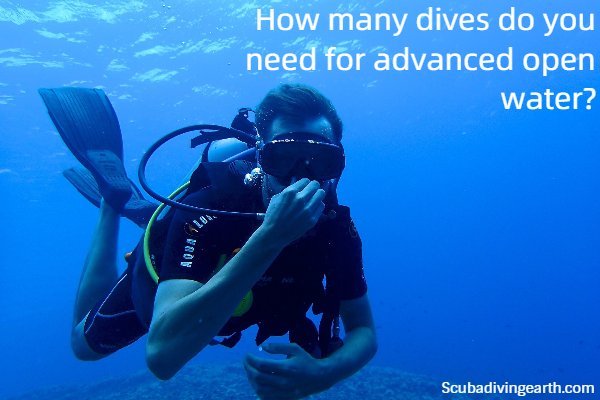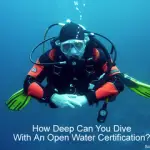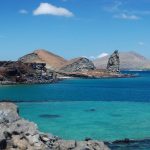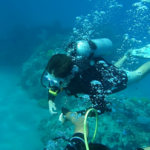
If your are wondering how many dives you need for Advanced Open Water Diver which is your next step on your scuba diving journey after completing your Open Water certification level. But is Advanced Open Water worth it? Let’s take a look…
How many dives do you need for Advanced Open Water Diver? The number of dives you need for Advanced Open Water Diver includes five different adventure dives. The five adventure dives must include the Deep Diver speciality course and the Underwater Navigator course. Then you choose three or your favourite dives from other speciality dive courses. The course takes 2 to 3 days.
The best way to do more diving is to book yourself on a scuba diving liveaboard. You can check the latest and best deals on liveaboards using the following window:
What is required for Advanced Open Water Diver?
Before you embark on taking that next step in your scuba diving journey to get your Advanced Open Water Diver (AOWD) diver certification, take time to build your experience first as an Open Water Diver.
This applies to which ever dive school you trained with. But of course for AOWD, this is obviously PADI training.
It’s not a race and for your own safety it’s better to build your experience slowly. With your Open Water certification you can already dive to 18 metres (60 feet).
With this depth there are plenty of great dives to do where you’ll be able to build your confidence underwater. But also to build familiarity with your diving equipment. It takes time to fully control your buoyancy and to safely ascend from dives with confidence.
But assuming you’ve already done this, what is required for Advanced Open Water Diver?
Requirements for Advanced Open Water Diver
For you to take the PADI Advanced Open Water Diver certification course, you need the following:
- First you need to be at least 15 years old (although the Junior Advanced Open Water Diver course you have to be 12 or older).
- Secondly, you need to be a certified PADI Open Water diver. It is this initial certification, combined with your diving experience which gives you the necessary core competencies to move up to the advanced level.
- Third, and this is in my opinion only and not a requirement of PADI; You should build up your experience at Open Water certification level before you move up a level. This should include at least 10 dives if not 20 dives to be safe underwater.
- Finally, as with any scuba diving, you should be fit and healthy to dive.
Regarding my recommendation in point 3 above: Think about it in relation to driving a car. At Open Water Level you are required to complete 5 dives also (see below for AOWD).
Which means that if you did no other dives other than your training dives. If you then went straight to your Advanced Open Water Diver certification. At the end of your training to AOWD level you’d have just 10 dives under your belt.
Going back to the driving a car analogy: Assuming you’d never driven a car before. But then you were taken out by a driving instructor on ten 30-40 minute drives. At the end of those 300-400 minutes of driving would you feel comfortable calling yourself an Advanced Driver? I doubt it.
For me the same goes for scuba diving. But then maybe that’s just me being old fashioned in my scuba diving training and thinking.

How many dives do you need for Advanced Open Water Diver?
Not withstanding my opinion above about gaining more experience at the Open Water certification level and doing at least 10-20 dives. The PADI Advanced Open Water Diver certification consists of 5 (five) different adventure dives.
Of these five adventure dives there are two adventures dives that are a requirement. Then there are three additional dives which you can choose from a range of the other adventure dives. Thus making a total of five adventure dives to become a certified Advanced Open Water Diver.
The two required adventure dives out of the five in total
- Deep Diver: During this Deep Diver course you’ll learn how to plan dives to depths of up to 40 metres (130 feet). You will also learn how to deal with the physiological effects and challenges of deeper scuba diving. Subjects live nitrogen narcosis and decompression are included in the course.
- Underwater Navigator: The Underwater Navigator course will refine your underwater compass navigation skills. The course will help you to better navigate using kick-cycles (i.e. each completed upward and downward sweep of your fin underwater), using visual landmarks and time.
Adventure dives to choose your additional three dives to complete the five in total
The alternative PADI speciality courses can be split between the most popular alternative adventure dive courses vs the other course you may choose as part of your Advanced Open Water Diver certification.
However, be aware that not all of these courses will be taught at allPADI dive centres. For example, you’re unlike to be taught how to use a dry suit in the Caribbean.
The most popular and recommended PADI speciality courses for Advance Open Water certification:
- Enriched Air Diver: The Enriched Air Diver course is the most popular PADI specialty course. Scuba diving with enriched air nitrox gives you more no decompression time, which is especially the case on repetitive scuba dives on for example a liveaboard trip.
- Peak Performance Buoyancy Adventure Dive: The Peak Performance Adventure Dive helps with the observation of aquatic life without disturbing their surroundings. It also helps you to improve your buoyancy skills you learned as a new diver and elevate them to the next level.
- Digital Underwater Photography: The Digital Underwater Photography diving is one of the most popular diving speciality courses, which helps you to capture images of your underwater scuba adventures.
- Dry Suit Adventure Dive: During the Dry Suit Adventure Dive you learn to use a dry suit, about dry suit squeeze and how to control buoyancy in a different way. This is an ideal course if you intend to dive in cold waters.
- Boat diver: The Boat Diver course helps you to expand your knowledge about boats. This is from small inflatables to large liveaboards.
- Drift Diver: The Drift Diver speciality course teaches you how to enjoy diving in an underwater current either diving with the flow down a river or in an ocean currents. Drift diving is both relaxing and great fun and is like you’re flying underwater!
- Night Diver: Night diving is one of my personal favourites. On the Night Diver course you find out about how the underwater world changes as day creatures go to sleep and the nocturnal creatures awake.
- Wreck Diver: The Wreck Diver speciality course is about how to safely enjoy diving on underwater wrecks which includes shipwrecks, tanks and other military wreckage, planes, busses and even cars.
Other PADI speciality courses for Advance Open Water certification:
- Sidemount Adventure Dive: One the Sidemount Adventure Dive you learn how to dive using side-mounted dive tanks (i.e. with your scuba tanks alongside you). This can offer more flexibility and makes you more streamlined.
- Coral Reef Conservation: The Coral Reef Conservation dive will help you to appreciate the complexity of coral reef habitats. It also teaches you how to help conserve these vital underwater systems.
- Ice Diver: The Ice Diver course is probably one of the most adventurous scuba diving specialities. Ice diving is one type of dive not experienced by many divers.
- Altitude Diver: The Altitude Diver course teaches you about diving in altitudes higher than 300 metres (1000 feet) above sea level.
- Cavern Diver: The Cavern Diver course is about how to safely dive and explore caves and caverns. It’s about how to enter far enough for adventure, but not too far to make sure of an easy exit back to open water.
- Fish Identification: The Fish Identification course is to help you enjoy your dives more when you’re able to identify the fish and other sea creatures around you.
- Project AWARE Specialist: The Project AWARE Specialist course you’ll learn how you can make a difference for ocean protection each time you dive or travel.
- Search and Recovery Diver: The Search and Recovery Diver course will teach you how to retrieve lost items that have fallen overboard or over a the side of a dock or habour. Plus learning how to use a lift bag for heavy objects.
- Underwater Naturalist: The Underwater Naturalist course is about having a better understanding about the local ecosystem and the differences between terrestrial and aquatic worlds.
- Adaptive Support Diver: The Adaptive Support Diver course is about increasing your awareness of other divers’ varying abilities or a disability.
- Advanced Rebreather Diver: The Advanced Rebreather Diver course teaches you how to dive using a rebreather. Learn to dive in silence to as deep as 40 metres (130 feet). On this course you learn about scrubbers, oxygen consumption and bailout requirements including how to configure a rebreather bailout cylinder system.
- Adaptive Techniques: The Adaptive Techniques course explores adaptive teaching techniques to apply when training and diving with physically and mentally challenged divers.
- Emergency Oxygen Provider: The Emergency Oxygen Provider course is about how to immediately recognise how and when to administer oxygen to a scuba diver who has for example Decompression Sickness.
- Equipment Specialist: The Equipment Specialist course teaches you how to manage basic scuba diving equipment repairs and adjustments.
- Multilevel Diver: The Multilevel Diver course teaches you how to extend your underwater time. You’ll learn about multilevel diving and how to calculate for multilevel dives.
- Underwater Videographer: The Underwater Videographer course will you you to capture the sights, sounds, and the dynamic motion of the underwater world as a videographer.
Is Advanced Open Water worth it?
Advanced Open Water Diver certification may only be worth it if you intend to dive deeper than 18 metres (60 feet). However, in my mind I think it’s far more fundamental that about the depth of your diving.
Advancing your skill and certification levels will make you a better scuba diver and a safer one too. As part of the Advance Open Water diver course you get the chance to complete five Adventure dive courses, as listed above.
For me there are a few skills in this list that I’d not want to be without. Aside from the two require adventure dives, for me these include: Drift Diver; Night Diver, Wreck diver, Dry Suit Adventure Diver and possibly Enriched Air Diver.
With these additional skills under your scuba diving belt you can do most dives from then on.
Liveaboard diving
If you’ve ever fancied diving on a liveaboard, Advance Open Water diver will open you up to so many more dive boats and destinations. For example, I’ve written many reviews about Maldives liveaboard boats. Diving in the Maldives can involve strong currents (drift diving experience needed), deeper dives (Deep diver course will help on this) and the pleasure of night dives (the night diving course will give you the necessary skills for this).
By having all these additional skills you won’t ever need to skip a dive and enjoy all the dives on the trip.
Diving and travel insurance
It’s also worth noting about your diving or travel insurance at this stage. If you go beyond the depth of your certification level (e.g. 18 metres (60 feet) ofr Open Water) your insurance company are unlikely to pay out should you run into a problem at a depth deeper than 18 metres.
What is the difference between PADI Open Water and Advanced Open Water Diver?
Both levels of certification Advanced Open Water Diver (AOWD) and Open Water Diver (OWD) are recreational scuba diving certifications.
The most important difference between OWD and AOWD is that the depth limit is increased from 18 metres (60 feet) to 30 metres (198 feet).
The other differences will include the additional skills you learn as detailed above. However, you don’t have to do the Advanced Open Water Diver certification to be able to do some of the above speciality courses, as you can still do these as an Open Water Diver too.
I hope you enjoyed this article about how many dives do you need for Advanced Open Water Diver
I’d love to hear from you. Tell us about your adventures of diving and snorkelling. Please use the comments section below. Please also share your photos. Either from your underwater cameras or videos from your waterproof go-pro’s!
If this article hasn’t answered all of your questions. If you have more questions either about snorkelling or scuba diving (or specifically about how many dives do you need for Advanced Open Water Diver), please comment below with your questions.
There will also be many more articles about scuba and scuba diving safety tips (and on snorkelling too) for you to read and learn about this fabulous sport.
Have fun and be safe!





